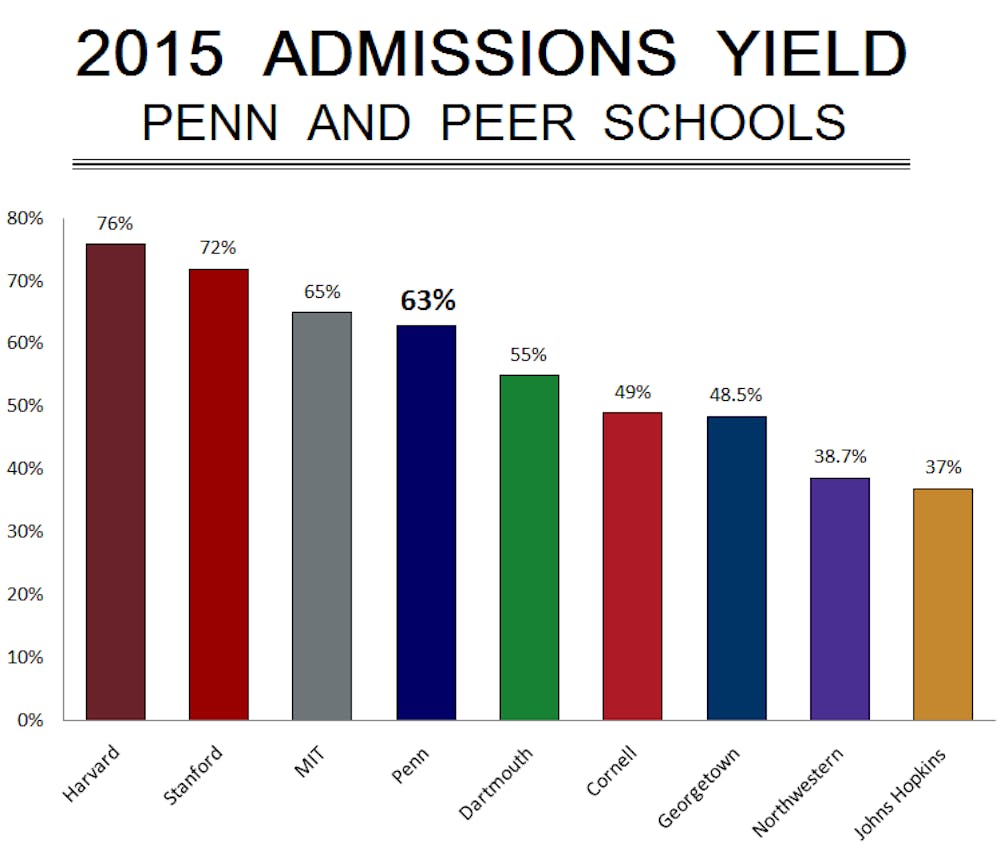For the fourth consecutive year, Penn’s yield rate — the percentage of prospective students who accept admissions offers — has remained steady at 63 percent.
For the Class of 2015, the University will enroll 2,476 of 3,917 admitted students, Dean of Admissions Eric Furda said. This number includes the 37 students who have been taken off the waitlist so far.
Penn falls in the middle of the pack when compared to peer schools that have released their overall yield numbers. Harvard and Stanford universities reported higher yield rates of 76 and 72 percent, respectively. Cornell University at 49 percent and Dartmouth College at 55 percent both fell below Penn.
Penn’s yield rate for regular decision alone — excluding the 1,195 students who were admitted through early decision — is 47 percent, which is also similar to recent years’s rates.
Though this year’s yield does not mark an increase from the past few years, Furda said he is pleased by the overall strength of the Class of 2015.
“We’ve increased not only the quality of our incoming class, but also the diversity,” he said, “and to keep yield consistent while doing those things is a very positive step.” He added that final enrollment numbers depend on “a lot of externalities that we don’t have direct control over.”
Furda attributed the University’s success in attracting top students to renewed efforts to get more undergraduates involved in the admissions and recruitment processes.
Earlier this year, Furda helped create the Admissions Dean’s Advisory Board, a group of students that meets to discuss admissions initiatives. In early March, ADAB members helped create videos highlighting the “Penn experience” that were sent out to more than 200 likely letter recipients.
After regular decision results came out at the end of March, the Quaker Opportunity and Access Team — a student group created in the fall semester to reach out to minority, low-income and first-generation applicants — sent hand-written postcards to admitted students.
Furda said both forms of one-on-one outreach “have seemed like they’ve been well received.”
Compared to last year, waitlist activity for the Class of 2015 saw a slight decline. Though Furda is unsure if the Admissions Office will take any more students off the waitlist, he said the incoming class will be finalized by the end of the month.
An additional 63 students who took gap years last year will be joining the freshman class in the fall, he added.
With both Princeton University and Harvard set to bring back early action programs for the Class of 2016, Penn could experience a jump in yield next year, according to Steven Goodman, an educational consultant with Top Colleges.
Goodman, who received his master’s degree in 1989 from Penn’s Graduate School of Education, said the new admissions policies might mean less head-to-head overlap between Ivy League schools in the regular decision round, which could lead to greater interest in Penn among admitted students.
Bev Taylor, founder of The Ivy Coach, added that the University should not be surprised if it experiences slight fluctuations in its yield in the next few months due to a process she called “summer melt.” The process, Taylor explained, occurs when students decide not to matriculate at the school they originally chose, often because of last-minute acceptances off other schools’ waitlists.
On the whole, Taylor said she was impressed with Penn’s performance in this year’s admissions cycle. “They seem to have a good sense of who’s going to come if accepted,” she said.



